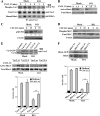Rap1-GTP-interacting adaptor molecule (RIAM) protein controls invasion and growth of melanoma cells
- PMID: 21454517
- PMCID: PMC3099666
- DOI: 10.1074/jbc.M110.189811
Rap1-GTP-interacting adaptor molecule (RIAM) protein controls invasion and growth of melanoma cells
Abstract
The Mig-10/RIAM/lamellipodin (MRL) family member Rap1-GTP-interacting adaptor molecule (RIAM) interacts with active Rap1, a small GTPase that is frequently activated in tumors such as melanoma and prostate cancer. We show here that RIAM is expressed in metastatic human melanoma cells and that both RIAM and Rap1 are required for BLM melanoma cell invasion. RIAM silencing in melanoma cells led to inhibition of tumor growth and to delayed metastasis in a severe combined immunodeficiency xenograft model. Defective invasion of RIAM-silenced melanoma cells arose from impairment in persistent cell migration directionality, which was associated with deficient activation of a Vav2-RhoA-ROCK-myosin light chain pathway. Expression of constitutively active Vav2 and RhoA in cells depleted for RIAM partially rescued their invasion, indicating that Vav2 and RhoA mediate RIAM function. These results suggest that inhibition of cell invasion in RIAM-silenced melanoma cells is likely based on altered cell contractility and cell polarization. Furthermore, we show that RIAM depletion reduces β1 integrin-dependent melanoma cell adhesion, which correlates with decreased activation of both Erk1/2 MAPK and phosphatidylinositol 3-kinase, two central molecules controlling cell growth and cell survival. In addition to causing inhibition of cell proliferation, RIAM silencing led to higher susceptibility to cell apoptosis. Together, these data suggest that defective activation of these kinases in RIAM-silenced cells could account for inhibition of melanoma cell growth and that RIAM might contribute to the dissemination of melanoma cells.
Figures








Similar articles
-
Focal adhesion disassembly is regulated by a RIAM to MEK-1 pathway.J Cell Sci. 2012 Nov 15;125(Pt 22):5338-52. doi: 10.1242/jcs.105270. Epub 2012 Sep 3. J Cell Sci. 2012. PMID: 22946047
-
RIAM activates integrins by linking talin to ras GTPase membrane-targeting sequences.J Biol Chem. 2009 Feb 20;284(8):5119-27. doi: 10.1074/jbc.M807117200. Epub 2008 Dec 19. J Biol Chem. 2009. PMID: 19098287 Free PMC article.
-
RIAM, an Ena/VASP and Profilin ligand, interacts with Rap1-GTP and mediates Rap1-induced adhesion.Dev Cell. 2004 Oct;7(4):585-95. doi: 10.1016/j.devcel.2004.07.021. Dev Cell. 2004. PMID: 15469846
-
The adaptor molecule RIAM integrates signaling events critical for integrin-mediated control of immune function and cancer progression.Sci Signal. 2017 Aug 22;10(493):eaam8298. doi: 10.1126/scisignal.aam8298. Sci Signal. 2017. PMID: 28831022 Review.
-
The MRL proteins: adapting cell adhesion, migration and growth.Eur J Cell Biol. 2012 Nov-Dec;91(11-12):861-8. doi: 10.1016/j.ejcb.2012.03.001. Epub 2012 May 1. Eur J Cell Biol. 2012. PMID: 22555291 Review.
Cited by
-
Nuclear SIPA1 activates integrin β1 promoter and promotes invasion of breast cancer cells.Oncogene. 2015 Mar 12;34(11):1451-62. doi: 10.1038/onc.2014.36. Epub 2014 Apr 7. Oncogene. 2015. PMID: 24704834
-
Expression of the phagocytic receptors αMβ2 and αXβ2 is controlled by RIAM, VASP and Vinculin in neutrophil-differentiated HL-60 cells.Front Immunol. 2022 Sep 27;13:951280. doi: 10.3389/fimmu.2022.951280. eCollection 2022. Front Immunol. 2022. PMID: 36238292 Free PMC article.
-
Conformational activation of talin by RIAM triggers integrin-mediated cell adhesion.Nat Commun. 2014 Dec 18;5:5880. doi: 10.1038/ncomms6880. Nat Commun. 2014. PMID: 25520155 Free PMC article.
-
RIAM (Rap1-interacting adaptor molecule) regulates complement-dependent phagocytosis.Cell Mol Life Sci. 2013 Jul;70(13):2395-410. doi: 10.1007/s00018-013-1268-6. Epub 2013 Feb 19. Cell Mol Life Sci. 2013. PMID: 23420480 Free PMC article.
-
Aggressiveness of human melanoma xenograft models is promoted by aneuploidy-driven gene expression deregulation.Oncotarget. 2012 Apr;3(4):399-413. doi: 10.18632/oncotarget.473. Oncotarget. 2012. PMID: 22535842 Free PMC article.
References
-
- Bos J. L. (2005) Curr. Opin. Cell Biol. 17, 123–128 - PubMed
-
- Bos J. L., Rehmann H., Wittinghofer A. (2007) Cell 129, 865–877 - PubMed
-
- Lafuente E. M., van Puijenbroek A. A., Krause M., Carman C. V., Freeman G. J., Berezovskaya A., Constantine E., Springer T. A., Gertler F. B., Boussiotis V. A. (2004) Dev. Cell 7, 585–595 - PubMed
Publication types
MeSH terms
Substances
Grants and funding
LinkOut - more resources
Full Text Sources
Medical
Research Materials
Miscellaneous

